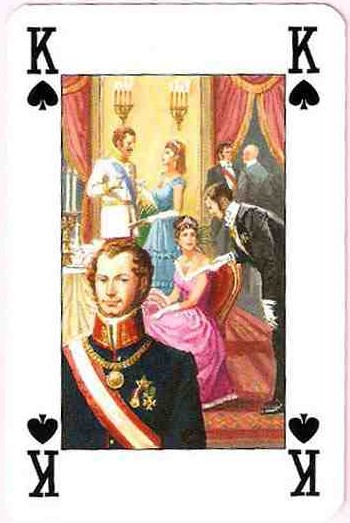INTRODUCTION
A first note dealing with card playing in the Stanze of Cocomero informed on the years 1799-1807.(1) It contained all the basic references to the place and to the archival documents available for study; they will not be repeated here. This second note on the same subject continues the description up to 1829. In particular, the beginning of the year 1807 is covered in the first note, and its last part here.
Political background
As in the previous time interval, great changes were occurring in the years under study. These involved the rulers themselves of the Grand Duchy of Tuscany, with Ferdinand III of the Lorraine-Hapsburg House first removed and then coming back after the defeat of Napoleon.
In the time involved in this study, we begin with a Kingdom of Etruria, which passes from the Bourbon House to the sister of Napoleon, Elisa, soon completely losing its independence and becoming directly included into the French Empire. Under the French administration, Tuscany was divided into three departments Arno in the centre, Mediterranean in the Western part, and Ombrone in the South.
After the Congress of Vienna of 1815, Ferdinand III again was acknowledged as the Grand Duke of Tuscany, until his death in 1824; his son Leopold II succeeded as Grand Duke and ruled Tuscany as a rather liberal monarch, in particular with remarkable independence from Vienna.
Documents studied
As in the previous case, the basis of this note has been found in different items of the TN section in ASCFI. We have again here both a couple of registers and a folder (Filza, string of paper sheets) of the corresponding receipts; in this case, the registers are TN 31 and TN 40, with the corresponding Filza of receipts TN 47.
The registers are bigger than the previous ones, with their 36x23cm dimension and about 150 folios. TN 40 is titled “Accademia degli Infuocati per il provento del giuoco. Entrata e uscita. A”. TN 31, the second register, has a different title, “Debitori e creditori. A”, and has been differently organised with several sections of contents.
More useful has been TN 40; its overall structure is the same as in the previous register studied, TN 39. First we find the Entrate section, up to p.17, followed by several blank folios, then on f.26 the Uscite section begins and continues up to f.46. The third part, Quaderno di Cassa, is lastly inserted on ff.51 to 148.
As a matter of fact, several intermediate sections have been inserted in these pages, in which the same expenses (in this case) have been collected together according to the their kind: separately, all the records of the rent moneys, of the salaries, of the expenses for lightning, and - extraordinarily useful for us - all the expenses for playing cards, under the title Spese di Carte. It has thus been unusually easy to deduce from the documents the tables reported here.
There is moreover a separate notebook of smaller dimension inserted at the beginning of the register, in which the various topics have been indexed and the corresponding folios indicated. The list we are interested in is a continuous one, but we find it on ff.52, 69, 83, 93, 101, 114, 126, 136, 147. It may remind us of a serial published in a periodical.
This is the same kind of collecting the individual records, as we had found in TN 30 for the previous years; here the lists appear to be more complete and more coherent with the rest of the register.
This method of collecting the records, which has been mentioned as particularly useful for us, is present also in the second register of the series, TN 31: it has very similar lists of Spese di Carte, recorded on ff.18, 36, 43, 53, 62, 69, 85, and 94. The main difference is that in this case the lists take into account the incomes derived from selling second-hand cards, which can also be found, inserted individually and in chronological order, in the income section of TN 40.
These lists continue for a few of the following years, with however less detail. The records for times later than 1829 will be taken into account in a following note.
Moreover, we have here too the corresponding Filza of receipts kept, TN 47, as was item TN 66 for the previous years. This folder however does not cover the whole time interval, but only its second part, from 1 May 1817 to 30 April 1829. It is a thick folder with about half thousand loose sheets, and this time the old system of piercing them together has not been preserved. I have examined these receipts, and found no additional information worth reporting.
In these receipts there is no cost recorded in Scudi, as in the registers for these years. The account system used in the receipts is only based on the three-digit L.s.d. that had been in common use for centuries.
There are further registers dealing with the same years, and with the same format and vellum paper binding, and in particular TN 38, TN 42, TN 43: I have leafed through them too, but found no further information for our aims.
Kinds of playing cards
The kinds of cards acquired are essentially the same as before, Carte Basse and Minchiate, at least in the initial years. We never find any indication of different kinds of Minchiate produced. Basse can certainly be considered to correspond to the common 40-card pack.
There is however a little uncertainty whether Basse could be Grandi or Piccole. In many cases, they are indicated as Grandi, but in most cases they are recorded without any attribute. Only in very seldom occurrences we read of both Grandi and Piccole acquired together. I suppose that these are the only cases in which Piccole were present. This assumption can be confirmed, in particular, with the observation that there is no difference in price between Basse and Basse Grandi, whenever they are indicated as such.
What is surprising is another kind of packs, the complete pack of 52 cards, indicated as Picchetti. Actually it is not surprising that it was used too – more surprising is the fact that it was introduced in the Stanze only in 1821, at least if we limit our attention to remarkable quantities of packs.
The traditional game that comes at once to our mind is of course Whist. This new association of pack and game could hardly be different, even though the year 1821 may be considered a little late for the introduction of this innovative game, capable to establish a new and lasting craze.
In any case, it may be of some interest to associate the appearance and multiplication of Picchetti, with the simultaneous sensible decrease in the consumption of Minchiate. Minchiate had already suffered some rather sudden decrease in popularity, but never was recorded here a sudden crisis as in the years 1821-22.
This was not a definitive disappearance, as observed about half century later on, but a few years were needed for Minchiate to resume something similar to the previous popularity. This occurred at the end of the time interval under study, when it was the 52-card pack to show a decrease in popularity in its turn.
Packs purchased per year
I have collected together the purchases for each year; a system of summing the packs which is not present in the registers TN 31 and TN 40. There is too some need to provide yearly balances, but these are reported only for the money involved, not the packs. Moreover, the yearly balances in the registers (here and in other cases) cover the interval from 1 May to 30 April of the following year.
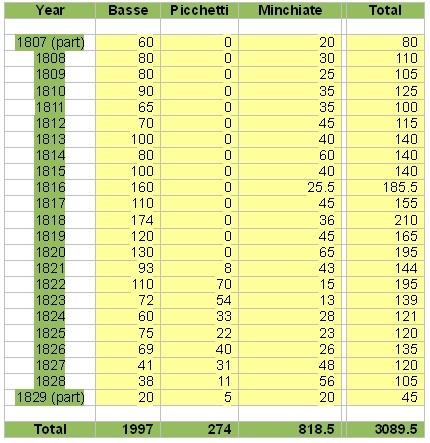
We may deduce from the table an average value of 134.2 dozens for card packs acquired yearly, out of which 35.6 of Minchiate, corresponding to about 26.50 per cent, evidently still a very high fraction, comparable to the value of about 23% found for the previous years. (1)
For 1807, the first year in the list, it is possible to add to the figures of 60 and 20 of the table the corresponding values of 30 and 5 of the previous study, thus obtaining 90 dozens of Basse and 20 of Minchiate for the whole year.
In terms of card packs, we had found for the years 1799-1807 in the previous note(1) that the yearly consumption was of roughly 1000 packs of Basse and 300 of Minchiate. Here we find remarkably increased values, by about 60% for the grand total of all the packs acquired yearly; the increase was somewhat lower for Minchiate.
Purchases of playing cards
In the table above, the dozens of packs purchased in every year from 1897 to 1829 are reported, but there is some additional comment that can only be stimulated by examining the individual purchases, listed in the appendix.
There is a remarkable regularity in the purchases of playing cards for the Stanze. About every month a new batch of cards is paid, often around the 20th of the month. As traditional, cards are traded by the dozens. A prevalent number of fifteen dozen packs is observed for each batch - often we find ten dozens of Basse and five of Minchiate.
Sometimes the two sections of dozens mentioned are present individually, more often a single batch of ten Basse, but also sometimes five of Minchiate: these cases seem to indicate that there remained still enough packs of the other kind.
Remarkable is moreover how the situation changed with the appearance in the trade of the third kind of Picchetti. We still often observe the purchase of fifteen dozen packs in a batch, and in particular a representative case could be 5 Basse, 5 Picchetti, 5 Minchiate, or 5-5-5. This case was actually recorded, but there were ample variations: the “usual” total amount of 15 could be formed by 6-4-5, respectively, or any else composition of the sum, as can be verified in the records of the appendix.
In the course of time, the fraction of Minchiate increased again, after an initially rather frequent 8-6-1, corresponding to the greatest vogue of the 52-card pack.
Sales of second-hand cards
In the appendix the sales of second-hand packs have been copied from the records in register TN 40, where they were inserted between all the other incomes, and verified with the lists of TN 31. Apart from some missing values, the information is fairly complete, because the keeper of the Stanze kept a cash-book with all items recorded. Then, every four months, the total was reported in the register and we find there almost all of the corresponding values, as copied in the appendix.
From the whole set of data the table below has been deduced for the yearly amounts of the second-hand cards sold by the Stanze.
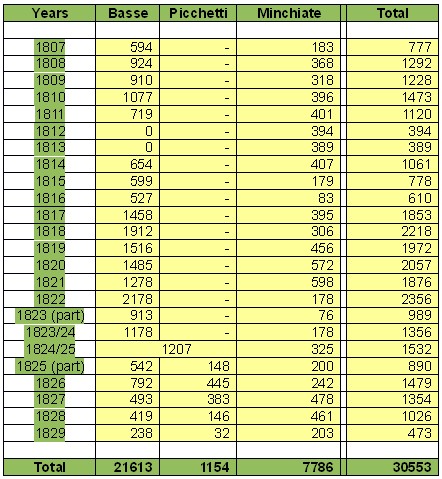
We do not have records for the individual periods of 1824 and 1825 (the values of the corresponding entries are from 1 May to 30 April of the following year), whereas for the following years we find Picchetti among the cards sold out. To be exact, the value 1207 for 1824/25 includes an unknown number of Picchetti too.
The ratio of second-hand Minchiate to all used cards sold is found as 25.48% for the whole set.
The following table compares the information from the previous tables of card purchased and sold out. The first row contains the values of the new card packs acquired: these amounts had already been reported in the corresponding tables as dozes - here those values have been multiplied by 12, for directly comparing them with the packs sold out.

The ratio of all card packs sold to all card packs purchased is near to a reasonable 82%; somewhat less, 79.27% for Minchiate.
Card prices
As for the previous years, I have copied in the lists of the appendix also the costs of the cards acquired. Here we meet a new way for keeping the accounts, in which we find a fourth value inserted before the “usual” L.s.d system, thus requiring four different units: the first value here corresponds to Scudi. The Scudo was a descendant of the florin and was valued as 7L. at the time.
Instead of inserting 0 values, dashes were used; they were often omitted after a whole number was obtained with the previous unit. For instance, -.2.5 was intended as 0 Scudi, 2 Liras, 5 Soldi, 0 Denari; or just 5, written instead of 5.0.0.0. Misunderstandings were hardly possible, because all these digits were put in the corresponding columns.
The prices of the cards changed a little in the course of time. Often, however, whole numbers of Liras were associated to one dozen of packs. A typical situation could be that of Basse costing 14L. for a dozen, Picchetti 16, and Minchiate 24. Of course, a price of 14L. gave a whole number of 2 Scudi too; the same occurred for Minchiate, when the correspondence was for 3 Scudi, or 21L., as in the initial years of the list.
Smaller changes in prices occurred, both up and down, as can be verified in the appendix.
The price of second-hand cards is not easy to deduce from the values recorded. Only seldom it has been expressly stated, as in 1826 when the price per pack is indicated as 13s.4d. both for Basse and Picchetti, whereas it was 16s.8d. for Minchiate; namely, 8L. and 10L. for a dozen, respectively.
The price of second-hand Minchiate can also be rather easily deduced from the values of 1812-14, when they were the only kind of second-hand cards sold out. The result is 13s.4d. for a pack, or 8L. for a dozen
Cardmakers
There was a kind of loyalty bond between the Stanze and the supplier of the playing cards. We know that several cardmakers were active at the time, but only exceptionally we find here a cardmaker different from Baragioli.
The Baragioli family is represented first by Vincenzio, and then by Giuseppe. Only between them we find a few purchases from Giovanni Pistoj. In correspondence with the purchases from Pistoj, we find recorded together the name of Giuseppe Berrettari, who apparently was at the time an assistant of Pistoj. Later on, we find him in other registers, and in particular as the manager of a state factory for the production of Minchiate, which was active in the last years examined here.(2)
Only for the first year we still find Luigi Moschini and his assistant (Ministro) Giovanni Battista Agostini, as found in some of the previous years.(1) Checking their receipts is useful, because they were compiled using a printed form: the kinds of cards ticked off were only two, as mentioned above, but we see that several other kinds of cards were offered on sale, as on the other hand we know from other sources.
In particular, we read on the six rows of the prescribed form: Minchiate, Basse, Piccole, Picchetti grandi, Picchetti piccoli, Alla Francese; in each row, two empty columns are arranged for inserting the number of dozens in the first and of packs in the second.
CONCLUSION
A previous study, focused on the years 1799-1807, has been extended here to cover the years 1807-1829. For these years, the purchases of playing cards to be used in the Stanze of Cocomero have been reported together with their costs, and discussed.
The purchases often were paid once in a month and the usual amount of playing cards was of fifteen dozen packs. Starting with 1821, a significant number of 52-card packs appeared together with the previously employed packs of 40 and 97 cards. The fraction of Minchiate was still very high, of around 26,5 per cent as an average value for the whole period.
It remains to extend the time interval investigated, and if possible to collect further information on that special milieu, certainly the most visited by card players in Florence at the time.
Footnotes:
(1) Franco Pratesi: 1799-1807 - FLORENCE : PLAYING CARDS AT COCOMERO (2013)
(2) Franco Pratesi: 1821-1829: PUZZLING MINCHIATE BY GIUSEPPE BERRETARI (2013) ; Franco Pratesi:1821-1829 – PUZZLING MINCHIATE REVISITED (2013)
|
Cocomero again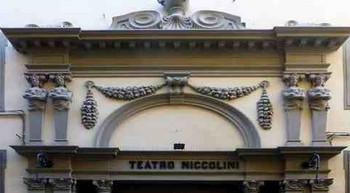

Minchiate, Prudentia
c. 1700
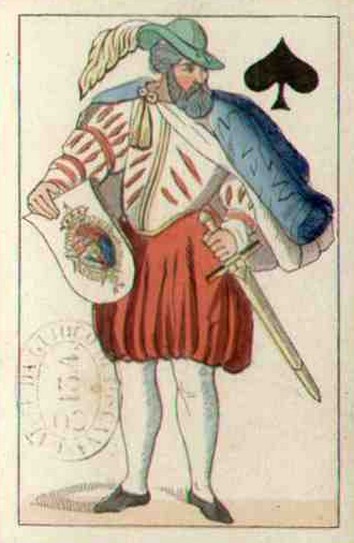
Fabbrica Baragioli" (Florence)
deck "Florentine", 1860
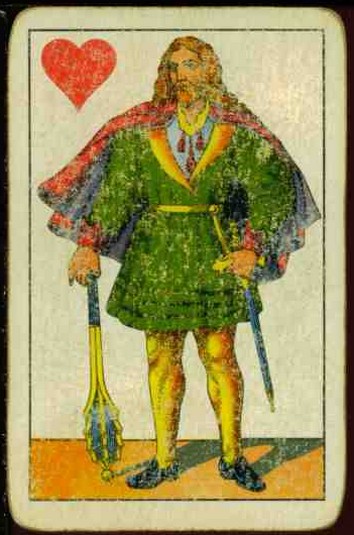
deck "Toscane No.93", since 1961 (?)
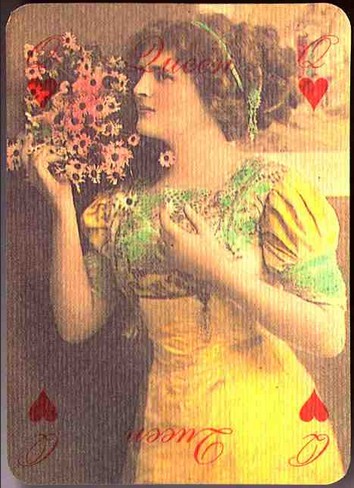
"Papier Arti e Mestieri" (Florence, Italy)
deck "Parigi 1800" (52+2J), 2000
made from old postcards
|
|



